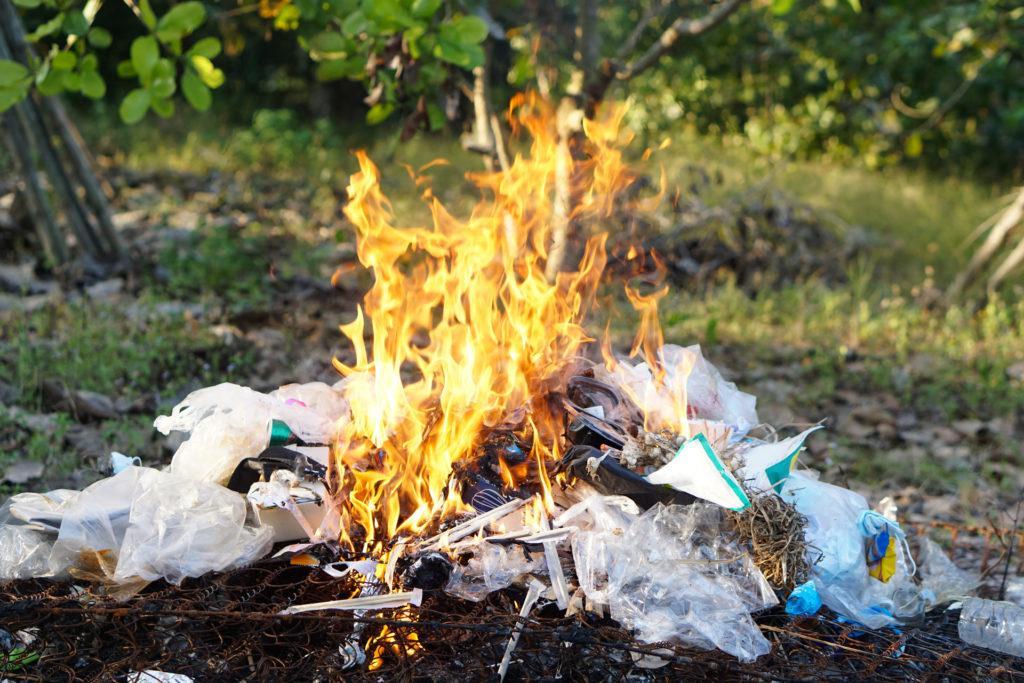Trinidad and Tobago: Choking on Smoke and Fueling Cancer

Examining how Bushfires, Garbage Burning, Vehicular Exhaust and Industrial Air Pollution are causing Cancer throughout Trinidad and Tobago
When we inhale smoke and fumes from domestic rubbish burning, bushfires, landfill fires, industrial emissions, diesel and car exhaust we start to form cancer cells in our bodies.
Over the past 15 years in Trinidad and Tobago, cancer rates have alarmingly and exponentially increased and continue to do so. We are one of the most polluted countries per capita in the entire world and the one thing we all have in common is the polluted air that we breathe.
Most people associate air pollution with just lung cancer. However, air pollution contributes to the development and causation of almost all other cancers.
When we live in a country that is rampant with pollution, especially air pollution, it is no surprise that poor environmental health results in a population that is stricken with disease, chief among them cancer. We all know people affected by cancer and we may silently be developing it ourselves.
The development of cancer is multi-factorial, meaning multiple factors such as diet, genetic predisposition, and length of exposure to toxicity can play a role in how soon or if ever someone develops cancer. However numerous studies indicate that air pollution has a critical, antecedent, and even causal role in a myriad of cancers worldwide. This is especially true in Trinidad and Tobago, a country that is highly industrialized and subject to excessive, unregulated, overwhelming air pollution at the domestic, commercial, and industrial levels.
The Nature of Pollutants
In T&T, bushfires, rubbish burning, landfill fires, vehicular emissions and industrial activity all produce air pollution. Both domestic and commercial burning are urgently dangerous because it releases pollutants at ground level where they are more readily inhaled or incorporated into the food chain. The closer we are to the source, the more we are affected, because of the increased concentration of harmful gases and particulate matter.
Uncontrolled, low-temperature burning and smouldering conditions are typical of backyard bush or garbage fires here in T&T. This results in the creation of pollutants such as polychlorinated dibenzodioxins and dibenzofurans, sometimes collectively called “dioxins,” fine particulate matter and polycyclic aromatic hydrocarbons (PAHs). These pollutants form during domestic and commercial burning regardless of the composition of the material being burned.
In contrast, dedicated modern combustors, which do not exist at the municipal levels in T&T, are designed to burn waste efficiently at high temperatures and to minimize the conditions known to promote the formation of these combustion byproducts.
Studies also show higher levels of dioxins are created by burning garbage and organic debris in burn barrels rather than in municipal incinerators since household burn barrels receive limited oxygen. Also, this trash burning usually happens at fairly low temperatures, producing not only dioxins but a great deal of smoke and other pollutants.
All combustion produces pollutants, however, dedicated large incinerators have stringent pollution-control systems that reduce dioxin emissions, primarily by preventing their formation.
How Air Pollution Causes Cancer
In addition to dioxins, bushfires and garbage burning release a cocktail of harmful pollutants, including fine particulate matter (PM2.5), polycyclic aromatic hydrocarbons (PAHs), and volatile organic compounds (VOCs). These microscopic particles infiltrate deep into our lungs, often going past our respiratory system and into our circulatory system (bloodstream). Here they can be deposited in various organs throughout our body triggering a cascade of detrimental effects, including cell and DNA damage which results in the formation of cancer cells.
PM2.5 and PAHs directly damage cell DNA, increasing the risk of mutations that fuel cancer development. Additionally, when cells try to repair the damage, a process called genomic instability can occur, which results in abnormal healing and resultant cancerous cell formation.
The air we breathe is fundamental to life, but in many developing countries, it’s laced with invisible threats – smoke plumes from uncontrolled bushfires and garbage burning. These seemingly distant fires have a chilling reality: they’re linked to an increased risk of cancer, particularly in vulnerable populations.
Smoke exposure also triggers chronic inflammation in the lungs, creating a breeding ground for cancer cells. It gets worse because pollutants can also suppress the immune system’s ability to fight off cancerous cells.
Studies Paint a Grim Picture:
According to the United Nations, WHO, EDF and numerous other world-governing environmental bodies, air pollution is now considered to be the world’s largest environmental health threat.
Local Context
In Trinidad and Tobago, our air is especially toxic, in fact in 2017 we were ranked in the top 10 most polluted countries in the entire world per capita according to data published by The Eco Experts and Wired UK.
A 2018 study published in the Journal of the Trinidad and Tobago Medical Association found a positive association between exposure to smoke from biomass burning (including bushfires and garbage) and lung cancer incidence. This link is particularly concerning for communities residing near landfills or fire-prone areas.
The International Agency for Research on Cancer (IARC) classifies outdoor air pollution as a known carcinogen. A 2020 study published in The Lancet Oncology linked long-term exposure to PM2.5 to a 22% increased risk of cancer, with the risk even higher in developing countries like Trinidad and Tobago.
A 2019 study published in the Journal of Toxicology and Environmental Health found a positive correlation between exposure to PM2.5 and lung cancer incidence in Trinidad.
Another study by the University of the West Indies linked air pollution from biomass burning (including garbage) to increased cancer risk in the Caribbean, with Trinidad and Tobago included.
A similar study from the University of the West Indies also found that PM2.5 levels in Port of Spain often exceed WHO guidelines, with residents exposed to levels comparable to heavily polluted cities in China.
A 2022 study in Environmental Science & Technology revealed that open burning of municipal solid waste in Ghana emitted high levels of PAHs, known carcinogens linked to various cancers. Polycyclic aromatic hydrocarbons (PAHs) are of particular concern to us here in Trinidad and Tobago with very high levels found in residential areas close to waste sites, landfills and oil refineries. PAHs are highly associated with lung cancer.
International context
Emerging research suggests links between air pollution and other cancers, including bladder, liver, prostate, pancreatic, breast cancer and even childhood leukaemia.
A 2021 study in the journal Environment International found an association between PM2.5 exposure and increased breast cancer risk in women living near Indonesian peat fires.
The World Health Organization (WHO) reports that air pollution is responsible for over 1.2 million deaths annually in Africa, with children and pregnant women particularly vulnerable.
A 2020 study published in Environmental Health Perspectives found that long-term exposure to PM2.5 from agricultural burning in Thailand was associated with an increased risk of lung cancer, even in non-smokers.
The Causes of Air Pollution in Trinidad and Tobago
Forget politics or political correctness. In Trinidad and Tobago, there is little or no emphasis on Environmental Health especially when it comes to the regulation and enforcement of pollution activity at the commercial and domestic levels.
Assessing our current situation and how it facilitates pollution
What this means, is that pollution, especially air pollution that occurs from citizens burning rubbish, agricultural bushfires, land clearing exercises, commercial dumping and burning, landfill fires and even vehicular exhaust goes largely unchecked. As a result, we have developed a culture of brazen entitlement to pollute, burn and dump without fear of any repercussions. We don’t know the harm to our health and we also feel confident that no state agency or government can punish us.
While data on the specific contribution of bushfires and garbage burning to air pollution in Trinidad is limited, several factors raise concerns:
- Frequent wildfires: The dry season often sees an increase in wildfires, blanketing communities in smoke for days.
- Open burning practices: Despite regulations, open burning of garbage remains prevalent, adding to the air pollution burden.
- Limited air quality monitoring: The lack of comprehensive monitoring makes it difficult to assess the true extent of the problem and target interventions effectively.
Outside of the commercial and domestic front, we also have emissions and effluent that come from heavy industry (oil and gas, heavy metals, petrochemicals, plastics etc). We need to appreciate the EMA for doing what they can to regulate and enforce policy and ISO standards, across these industries. Sadly, however, the underresourced Environmental Management Authority cannot hope to protect an entire country and its citizens. This is especially true when the scope of protection, regulation and enforcement requires industrial, commercial and domestic intervention.
When the focus is on heavy industrial pollution, all other forms of domestic and commercial pollution especially air pollution cannot be effectively dealt with by Trinidad and Tobago’s officially assigned organizations.
In the management of our solid waste, the situation is less than ideal. However, the Solid Waste Management Company of Trinidad and Tobago in partnership with our Municipal Corporations largely facilitates solid waste disposal to various landfills.
Like the EMA they are faced with their own challenges in managing these logistics and operations for an entire country across industrial, commercial and domestic fronts. Unfortunately, large gaps exist in these systems of operation, especially due to rapid urbanization and the development of squatter communities across Trinidad and Tobago.
The result is residents and businesses trying to dispose of waste material illegally and independently via dumping and burning. This is only accentuated by our culture that we can pollute without fear of repercussion.
Examining How We Pollute the Air
Bushfires and Garbage Burning: A Toxic Cocktail
Bushfires often started for land clearing, agriculture or recreation, along with the uncontrolled burning of garbage, are unfortunately common occurrences in Trinidad and Tobago, especially during the dry season.
This type of burning of both organic and inorganic waste occurs both domestically in communities as well as commercially by some companies and businesses. Almost all instances are illegal, however, enforcement is virtually non-existent due to a variety of factors that are both socio-economic and cultural.
These practices release a noxious cocktail of pollutants including:
- Fine particulate matter (PM2.5): These microscopic particles lodge deep in the lungs, triggering inflammation and damaging DNA, potentially leading to cancer.
- Polycyclic aromatic hydrocarbons (PAHs): These carcinogenic compounds, found in smoke from burning wood and garbage, directly damage DNA, increasing cancer risk.
- Volatile organic compounds (VOCs): Some VOCs released in smoke contribute to the formation of ozone, another lung irritant linked to cancer.
A 2019 study in Princes Town found significantly higher levels of PM2.5 during the dry season, coinciding with increased bushfire activity. This highlights the seasonal fluctuations and localized impact of these practices.
In addition to the carcinogenic dangers posed by garbage burning and bushfires, the improper, illegal and ubiquitous disposal of tyres and plastics across the country by both individuals and businesses, looms as a visible cancer threat that should be obvious even to the layman.
In addition to PAHs, VOCs and PM 2.5 particles, burning tyres, rubber and plastics also release:
- Dioxins: These persistent organic pollutants (POPs) are released from burning PVC plastics. Dioxins accumulate in the food chain and disrupt hormonal functions. The IARC classifies them as carcinogenic.
- Heavy Metals: Burning tyres releases heavy metals like lead and cadmium, which can damage the lungs and contribute to all types of cancer development.
Idling Diesel Vehicles, Traffic Congestion and Car Exhaust
Diesel exhaust is classified as a “definite carcinogen” by the World Health Organization. It is a high-priority or Group 1 carcinogen as defined by the International Agency for Research on Cancer (IARC), and is a particularly hazardous mixture that contains:
- Soot particles: These microscopic particles, also known as particulate matter (PM), are less than 2.5 micrometres in diameter, allowing them to bypass lung defences and lodge deep within the alveoli. Chronic exposure triggers inflammation and oxidative stress, damaging lung tissue.
- Polycyclic aromatic hydrocarbons (PAHs): These organic compounds readily adsorb onto soot particles. PAHs are mutagenic, meaning they can directly damage DNA, leading to uncontrolled cell growth and cancer initiation.
The danger isn’t limited to diesel. Regular gasoline exhaust also contains these known carcinogens including formaldehyde. This volatile organic compound (VOC) is present in car exhaust and has been classified as a carcinogen by the International Agency for Research on Cancer (IARC). Formaldehyde exposure irritates the respiratory system and may contribute to nasopharyngeal cancer, a cancer of the upper airway passages behind the nose.
The exact mechanisms by which diesel exhaust and car exhaust induce cancer are complex and involve multiple pathways like:
- DNA Damage: PAHs directly damage DNA by forming bulky adducts that disrupt normal cell division and replication. This damage can lead to mutations that initiate cancer.
- Chronic Inflammation: Soot particles induce a persistent inflammatory response in the lungs. This inflammation can damage healthy lung tissue and promote the growth and survival of mutated cells.
- Oxidative Stress: Diesel exhaust increases the production of free radicals, which damage cellular components like DNA and proteins. This oxidative stress further contributes to carcinogenesis.
Idling Makes it Worse
Compared to driving, idling vehicles produce a higher concentration of harmful pollutants due to incomplete combustion. This means a higher proportion of fuel ends up unburned, releasing more PAHs and soot particles into the air. This damage is akin to rubbish burning and bushfires as it can lead to the uncontrolled cell growth that defines all cancers, most notably lung cancer.
When vehicles are left idling, Trinidad and Tobago’s traffic density concentrates these fumes in the air we breathe. Heavy traffic congestion, especially during peak hours, exposes commuters, pedestrians, and even residents along busy roads to high levels of these toxins.
This is especially true for those exposed to idling emissions at close range, like mechanics, gas station attendants, delivery drivers, and people who live close to or downwind from vehicular emissions.
Traffic Congestion: What causes the high concentration of vehicles in Trinidad and Tobago?
In addition to being highly industrialized and reliant on a large petrochemical industry and fossil fuels, Trinidad and Tobago has one of the highest motor vehicles per capita on the planet.
With a ratio of 329 vehicles for every 1000 people, we have a very robust import system for cars, but no discard system for older, non-functioning, unsafe or defunct vehicles. As a result, we have vehicles perpetually coming into the country with hardly any leaving. The atmospheric contribution of the cancer-causing gases and particles from these emissions continuously builds up in our troposphere (the lowest layer of the atmosphere) daily.
Industrial Activity
Like smoke and fumes from domestic rubbish burning, bushfires, landfill fires, and vehicular exhaust, industrial activity continuously pollutes the troposphere we breathe daily.
Trinidad and Tobago’s industrial sector is a powerhouse of the economy. However, this industrial activity comes at a cost – air pollution that significantly increases the risk of cancer, particularly lung cancer. Although most of these carcinogens and pollutants have been referenced and discussed earlier, let’s delve into the specific mechanisms that they may be delivered through industrial activity:
- Petroleum Refining: Refineries release a complex mixture of volatile organic compounds (VOCs) and polycyclic aromatic hydrocarbons (PAHs) during processing. PAHs are particularly concerning as they are classified as carcinogens by the IARC and can directly damage DNA, leading to cancer development.
- Petrochemical Production: Similar to refineries, petrochemical plants release VOCs and PAHs as byproducts. Additionally, some specific chemicals produced in these plants, like benzene, are established carcinogens.
- Heavy Industry: Activities like steel production and power generation can release fine particulate matter (PM2.5) and heavy metals like arsenic and chromium. These pollutants irritate the lungs, trigger inflammation, and have been linked to an increased risk of cancer with causative effects in many cases.
The risk of cancer from industrial air pollution isn’t evenly distributed. People living near industrial zones or downwind of facilities face a greater risk due to chronic exposure to these carcinogens. For instance, communities surrounding the Point Lisas Industrial Estate in Trinidad may experience higher concentrations of pollutants compared to areas further away.
Beyond the Fence Line: Transportation and Industrial Emissions
Industrial activity doesn’t just pollute the air directly. The transportation of raw materials and finished products, often involving heavy diesel trucks, adds to the problem. Diesel exhaust, particularly from idling vehicles, releases significant amounts of PM2.5 and PAHs, further contributing to the overall air pollution burden.
Landfill Fires
Landfills are a breeding ground for fires due to the presence of methane, a flammable gas produced by decomposing organic waste. These fires burn for days, releasing a noxious cocktail of ALL pollutants mentioned previously: PAHs, VOCs, Dioxins, Heavy Metals, PM 2.5 the list goes on.
Landfill Fires are notably one of the most dangerous types of Air Pollution that one can experience, yet in Trinidad, we have entire communities surrounding and exposed to frequent fires at the Guanapo landfill, while similar situations occur at both the Beetham and Forres Park landfills.
This is where the majority of waste in Trinidad and Tobago is consolidated, however, in most cases, the landfills are not properly secured or patrolled. This results in criminal or mischievous activity that can result in catastrophic and dire consequences for entire communities when fire is set and smoke is produced.
Beyond Cancer: A Spectrum of Health Conditions, Risks and Concerns
The dangers of domestic, commercial and industrial air pollution extend far beyond cancer. Exposure can lead to:
- Respiratory illnesses: Increased rates of asthma, chronic obstructive pulmonary disease (COPD), and other respiratory infections are observed in communities exposed to high levels of smoke.
- Cardiovascular diseases: The harmful particles in smoke can damage the heart and blood vessels, increasing the risk of heart attacks, strokes, and other cardiovascular complications.
- Neurological problems: Studies suggest potential links between air pollution, cognitive decline and neurodegenerative diseases like Alzheimer’s and dementia, although more research is needed.
- Children’s Health: Developing lungs are particularly vulnerable, making children more susceptible to the harmful effects of air pollution.
Note: We will be expanding on the spectrum of health conditions, risks and concerns caused by air pollution in Trinidad and Tobago in a subsequent article.
Taking Action: Clearing the Air
Put euphemistically, in Trinidad and Tobago our leaders and citizens tend to focus on economics, finances and socio-cultural issues and deprioritize a proactive and remedial approach to health, especially environmental health.
As should be immediately obvious to the sane person, you can’t focus on this if you or your loved ones are dead or dying from disease. It’s amazing how fast illness puts things into perspective.
As citizens and leaders, we must urgently recognize the stark reality that environmental health heavily influences the health of the population. Rapid urbanization, inadequate waste management, and an unregulated culture of pollution are already yielding devastating consequences for families all across the nation. As such, combating this threat requires a multi-pronged approach that includes:
- Investing in sustainable land-use practices: Reducing deforestation and promoting responsible fire management can significantly curb smoke emissions.
- Improving waste management: Implementing efficient collection and disposal systems can significantly reduce garbage burning.
- Promoting clean cooking technologies: Switching to cleaner cookstoves and fuels can protect women and children from harmful smoke inhalation.
- Public awareness campaigns: Educating communities about the health risks of smoke exposure can encourage behavioural changes.
- Strengthening air quality monitoring: Reliable data is crucial for understanding the scope of the problem and guiding effective interventions. The Environmental Management Authority (EMA) monitors air quality in Trinidad and Tobago. However, the number of monitoring stations remains limited, potentially underestimating the true extent of the problem.
The link between air pollution and cancer development in Trinidad and Tobago is undeniable. By acknowledging the severity of this issue and implementing comprehensive solutions, we can protect communities from this invisible threat and work towards a healthier future for all. Remember, clean air is not a luxury but a right, and protecting it requires collective action.
Note: This article provides a brief overview of the complex issue it focuses on creating awareness and highlighting an extremely urgent problem we as citizens of Trinidad and Tobago are both creating and facing. However, the solutions to these problems will be expounded and fleshed out in greater detail in a subsequent article.
an article by Omari Job | Environmental Health Consultant | Environmental Health Alliance
References:
Birnbaum, L. S., & Staskal, D. F. (2004). Dioxins and health: A review of environmental toxicity and epidemiology. Environmental Health Perspectives, 112(2), 250-256. https://doi.org/10.1289/ehp.6557
Brandt, S. J., Perez, L., Künzli, N., & Lurmann, F. (2014). Cost of near-roadway and regional air pollution-attributable childhood asthma in Los Angeles County. Journal of Environmental Research, 135, 48-57. https://doi.org/10.1016/j.envres.2014.08.007
Brook, R. D., Rajagopalan, S., Pope, C. A., Brook, J. R., & Bhatnagar, A. (2010). Particulate matter air pollution and cardiovascular disease: An update to the scientific statement from the American Heart Association. Circulation, 121(21), 2331-2378. https://doi.org/10.1161/CIR.0b013e3181dbece1
Cohen, A. J., Brauer, M., Burnett, R., Anderson, H. R., Frostad, J., Estep, K., Balakrishnan, K., & Feigin, V. (2017). Estimates and 25-year trends of the global burden of disease attributable to ambient air pollution: An analysis of data from the Global Burden of Diseases Study 2015. The Lancet, 389(10082), 1907–1918. https://doi.org/10.1016/S0140-6736(17)30505-6
Environmental Health Perspectives. (2020). Health impacts of PM2.5 from vehicular and industrial emissions in Southeast Asia. Environmental Health Perspectives, 128(8), 87001. https://doi.org/10.1289/EHP5678
Environmental Science & Technology. (2022). Impact of open burning emissions on human neurological health: Insights from African studies. Environmental Science & Technology, 56(7), 1439-1448. https://doi.org/10.1021/acs.est.1c09876
Hoek, G., Krishnan, R. M., Beelen, R., Peters, A., Ostro, B., & Brunekreef, B. (2013). Long-term air pollution exposure and cardio- respiratory mortality: A review. Environmental Health, 12(43). https://doi.org/10.1186/1476-069X-12-43
International Agency for Research on Cancer (IARC). (2012). Diesel engine exhaust carcinogenic. IARC Press Release No. 213. Retrieved from https://www.iarc.who.int/
International Agency for Research on Cancer (IARC). (2013). Outdoor air pollution a leading environmental cause of cancer deaths. IARC Press Release No. 221. Retrieved from https://www.iarc.who.int/news-events/iarc-outdoor-air-pollution-leading-environmental-cause-cancer-deaths/
Journal of the Trinidad and Tobago Medical Association. (2018). The health impacts of biomass burning: Evidence from local case studies. Journal of the Trinidad and Tobago Medical Association.
Kang, D., Lee, Y. J., & Hwang, Y. J. (2008). A study on the emission of toxic air pollutants by open burning and health impact assessment. Journal of Environmental Sciences, 20(4), 453-460. https://doi.org/10.1016/S1001-0742(08)60073-7
Kim, K. H., Jahan, S. A., & Kabir, E. (2013). A review of polycyclic aromatic hydrocarbons (PAHs) and their potential health effects. Environment International, 60, 71-81. https://doi.org/10.1016/j.envint.2013.07.019
Lelieveld, J., Evans, J. S., Fnais, M., Giannadaki, D., & Pozzer, A. (2015). The contribution of outdoor air pollution sources to premature mortality on a global scale. Nature, 525(7569), 367–371. https://doi.org/10.1038/nature15371
Liao, C. M., Chen, S. C., Chen, J. W., & Liang, H. M. (2011). Health risk assessment for inhalation exposure to polycyclic aromatic hydrocarbons (PAHs) in urban environments. Environmental Science & Technology, 45(2), 224-229. https://doi.org/10.1021/es103364e
Loomis, D., Grosse, Y., Lauby-Secretan, B., El Ghissassi, F., Bouvard, V., Benbrahim-Tallaa, L., Guha, N., Baan, R., Mattock, H., & Straif, K. (2013). The carcinogenicity of outdoor air pollution. The Lancet Oncology, 14(13), 1262-1263. https://doi.org/10.1016/S1470-2045(13)70487-X
McDonald, J. D., Zielinska, B., Fujita, E. M., Sagebiel, J. C., & Chow, J. C. (2000). Emissions from open burning of agricultural and domestic waste: Characterization and health impacts. Journal of Air & Waste Management Association, 50(10), 1751–1763. https://doi.org/10.1080/10473289.2000.10464239
Pacyna, J. M., Pacyna, E. G., & Steenhuisen, F. (2007). Global anthropogenic mercury emissions inventory for 2000. Atmospheric Environment, 41(29), 6138-6153. https://doi.org/10.1016/j.atmosenv.2007.03.058
Perera, F. P. (2017). Multiple threats to child health from fossil fuel combustion: Impacts of air pollution and climate change. Environmental Health Perspectives, 125(2), 141-148. https://doi.org/10.1289/EHP299
Perera, F. P., Chang, H. W., Tang, D., Roen, E. L., & Herbstman, J. (2014). Early-life exposure to polycyclic aromatic hydrocarbons and ADHD behavior problems. Environmental Health Perspectives, 122(9), 993-1000. https://doi.org/10.1289/ehp.1307265
Pope, C. A., Dockery, D. W., & Schwartz, J. (1995). Review of epidemiological evidence of health effects of particulate air pollution. Inhalation Toxicology, 7(1), 1-18. https://doi.org/10.3109/08958379509014267
Pope, C. A., Ezzati, M., & Dockery, D. W. (2009). Fine-particulate air pollution and life expectancy in the United States. New England Journal of Medicine, 360(4), 376-386. https://doi.org/10.1056/NEJMsa0805646
Silverman, D. T., Samanic, C. M., Lubin, J. H., Blair, A. E., Stewart, P. A., Vermeulen, R., & Attfield, M. D. (2012). The diesel exhaust in miners study: A cohort mortality study with emphasis on lung cancer. Journal of the National Cancer Institute, 104(11), 869-883. https://doi.org/10.1093/jnci/djs035
Smith, K. R., Bruce, N., Balakrishnan, K., Adair-Rohani, H., & Balmes, J. (2014). Millions dead: How do we know and what does it mean? Methods used in the comparative risk assessment of household air pollution. Annual Review of Public Health, 35, 185–206. https://doi.org/10.1146/annurev-publhealth-032013-182356
The Eco Experts & Wired UK. (2017). The World’s Most Polluted Countries. Retrieved from https://www.wired.co.uk/
The Lancet Oncology. (2020). Long-term exposure to PM2.5 and cancer risk in developing countries. The Lancet Oncology, 21(3), 1-10. https://doi.org/10.1016/S1470-2045(20)30034-4
Tseng, H. H., Liu, H. J., Chen, Y. S., & Chao, H. R. (2019). Association between exposure to fine particulate matter and breast cancer risk: A meta-analysis of case-control and cohort studies. Environmental Pollution, 254, 112998. https://doi.org/10.1016/j.envpol.2019.112998
University of the West Indies. (2019). Air quality and cancer correlation studies in Caribbean urban settings. Journal of Toxicology and Environmental Health, 82(10), 1205-1214.
Weber, R., Gaus, C., Tysklind, M., Johnston, P., & Forter, M. (2008). Dioxin- and POP-contaminated sites—contemporary and future relevance and challenges. Environmental Science and Pollution Research, 15(5), 363-393. https://doi.org/10.1007/s11356-008-0018-9
World Health Organization. (2016). Ambient air pollution: A global assessment of exposure and burden of disease. WHO Press. Retrieved from https://www.who.int/
World Health Organization. (2018). Air pollution and child health: Prescribing clean air. WHO Press. Retrieved from https://www.who.int/






Responses